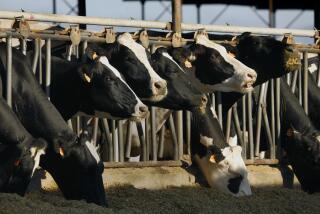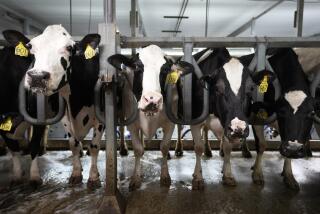Homeland Security Department develops foot-and-mouth disease vaccine
It’s not often that the Department of Homeland Security makes it into a science blog, but this is an unusual week. The department announced this week that it has developed the first vaccine for foot-and-mouth disease that can be manufactured and licensed in the United States and that could be used in the event of an outbreak of the disease in this country.
“This is the biggest news in [foot-and-mouth disease] research in the last 50 years,” said veterinarian Lawrence Barrett, director of the department’s high-containment Plum Island Animal Disease Center on the tip of Long Island, N.Y. The licensed vaccine is effective against only one strain of the virus, but vaccines against the other strains are already in development.
The foot-and-mouth disease virus has been recognized since at least the 16th century. It is characterized by fever, blisters on the feet and mouth, loss of appetite, drooling and lameness. Infected herds of animals are generally destroyed.
Large amounts of the virus are present in all body secretions, including breath, and are readily transmitted to other animals. The virus can also survive on the ground for extended periods of time and can be transferred on tires, boots and clothes. It has even been shown to be carried long distances by wind.
The United States has been free of the disease since 1929, but that is not a guarantee it will not return. Britain was free of the disease for 34 years before a 2001 outbreak that required the destruction of 10 million cows.
The costs of an outbreak in the United States could easily exceed $50 billion, which is why the Homeland Security Department is concerned. The virus is present today in Africa, the Middle East, Asia and parts of South America.
Vaccines against the virus are available, but they are based on a live virus and so cannot be legally manufactured in the U.S. Moreover, a vaccinated cow cannot be differentiated from one that is infected.
The virus consists of genetic material surrounded by a coat of proteins called a capsid. The new vaccine, originally developed by chemist Marvin J. Grubman of the U.S. Agriculture Department’s Agricultural Research Service at Plum Island, consists of the capsid alone. Those proteins produce an immune response to the virus, but without genetic material, the capsid is not infectious and does not cause disease.
Because a vaccinated animal does not carry any of the viral genetic material, moreover, it is easy to distinguish between a vaccinated cow and an infected one, Grubman said. The vaccine protects against only one of the seven known serotypes of foot-and-mouth disease, however.
The Homeland Security Department worked with GenVec Inc. of Gaithersburg, Md., and Antelope Valley Biologics of Lincoln, Neb., to manufacture and license the vaccine. Under the conditional license, the product could be distributed if the need for it arises.
LATimesScience@gmail.com
twitter.com/@LATMaugh






